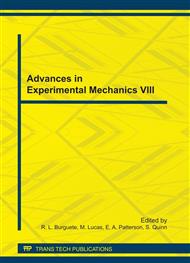p.165
p.171
p.177
p.183
p.189
p.195
p.201
p.207
p.213
Experimentation of Steel Fiber Reinforced Concrete Tri-Axial Split Strength under Quasi-Static Loading and High Strain-Rate
Abstract:
A split tensile test methodology has been established for the concrete spheriform specimens with the principal stress ratio of σ1:σ2:σ3=0.24:0.24:-1 in order to study the tensile-tensile-compressive tri-axial strength. Using a Universal Material Testing Machine and Split Hopkinson Pressure Bar, the quasi-static and dynamic spliting tensile tests have been conducted for the concrete spheriform specimens consisting of 1% steel fiber. In the quasi-static test, the average strain rate of the steel fiber reinforced concrete specimens was 8.3×10-5s-1 and the split tensile strength was found to be 0.77MPa, which is consistent with the existing literature. In the high strain rate tests, the average strain rate was 170s-1 and the split tensile strength was found to be 1.01MPa. When compared with the quasi-static testing results, it is seen that the split tensile strength of the steel fiber reinforced concrete increases with increasing strain rate. The split tensile test methodology established in the present paper is simple and inexpensive, while the strength obtained located on the meridian plane of tension and compression, has practical significance.
Info:
Periodical:
Pages:
189-194
Citation:
Online since:
August 2011
Authors:
Price:
Сopyright:
© 2011 Trans Tech Publications Ltd. All Rights Reserved
Share:
Citation:


